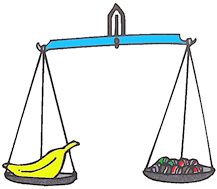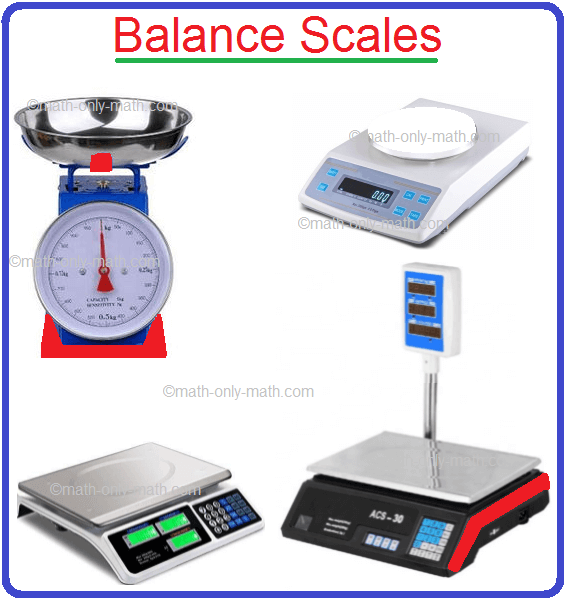Subscribe to our ▶️ YouTube channel 🔴 for the latest videos, updates, and tips.
What is Mass?
In third grade measurement of mass we will discuss about what is mass, standard unit of mass or weight etc,. The standard unit of weight or mass is gram and kilogram is the bigger unit of weight. We write as 'g' and kilogram as 'kg'. Kilogram is used to measure the heavier objects like a watermelon, school bag whereas gram is used to measure lighter objects like a chocolate, a tennis ball etc.
Concept of Mass/Weight
Look at the picture given on the right. Michael and Linda are sitting on a see-saw.
This Michael's side is lower than Linda's side. Why?
Michael is heavier than Linda. Michael weighs more than Linda.
Linda is lighter than Michael. Linda weighs less than Michael.
Now, look at the picture given below:
Richard and Ryan are also sitting on the see-saw.
The two sides of the see-saw are now at the same level.
Richard and Ryan have equal weights.
Definition of Mass/Weight: The property of an object which tell us how heavy it is, is called its weight.
|
We use a balance to compare weights. Look at the balance given on the right. It has a beam and two pans. Its beam is straight. Its pans are empty. The two pans are at the same level. Let us now use this balance to compare the weights of various objects. |
|
1. Take a banana and some marbles. Put the banana in one pan of the balance. It goes down. Now, put some marbles in the other pan. Go on adding marbles till the beam becomes straight. How many marbles have you put in the pan? The weight of the banana = _____ marbles. Weigh your pen and pencil box like this The weight of the pen = _____ marbles. The weight of the pencil box = _____ marbles. |
3. Weigh two apples with toffees.
The weight of the two apples = _____ toffees.
Marbles, chalk-sticks and toffees are non-standard units of weight.
What is mass?
The quantity of matter in an object is called its mass. We must know that the meaning of mass of a body is different from that of the weight of that body. The two terms, mass and weight, are different in the real sense. But in the initial stages for children, the difference is ignored and we use the terms weight and mass in the same sense. Weight of an object changes from place to place, above and below the surface of the earth, but mass of a body never changes. We know, in the surface of the earth we take the units of mass similar to the units of weight.
Standard Unit of Mass or Weight:
We have learnt to compare weights of two different things by using a balance. We find that, comparing weight of a watermelon with bananas is not the same when it is compared with mangoes. We need to use standard measures to find the weight or mass of any object. We use Grams and Kilograms to find out how heavy things are.
The standard unit of mass is kilogram and in short it is written as kg. It is used to measure the mass of heavy objects such as bags of grain, stones, etc. The smaller unit of mass is gram and in short it is written as g. It is used to measure the mass of lighter objects.
We know, 1000 g = 1 kg or 1 kg = 1000 g
We need standard units to weigh. For light objects we use grams (g) and for heavier objects we use kilograms (kg).
In a grocery shop we can see different weights to weigh different things.
Now, observe the following pictures. The shopkeeper is weighing vegetables in kilograms and grams and the girl is measuring her weight in kilograms.
The standard weights or blocks are used by a shopkeeper to weight different objects with the help of a common balance.
The standard unit of mass is the gram. The short form for gram is g. We use grams to weigh lighter things.
1000 grams makes one kilogram. We write kilogram as kg. We use kilograms to weigh heavier things.
Measure of Weight:
When we purchase solid objects like vegetables, rice, sugar etc. the shopkeeper measures them with the help of a balance and weights. He measures the weight in grams and kilograms. Some of the standard weights are shown below:
Different kinds of weight are used to weigh different things.
Visit a shop in the neighbourhood market. Hold the different weights in your hand and check how heavy each one is.
There are various types of balance scale available now a days to measure weights of different objects. Some of these scales have digital display to show the weight of an object.
To measure the weight of a given object, we place the object on one pan of the balance and weights are placed on the other pan.
When two objects weigh the same, the two pans of the balance stay at the same level.
In short, we denote kilograms by kg and grams by g.
1 kg = 1000 g
Review:
1. The quantity of matter in an object is call mass or weight.
2. Kilogram is useful for weighing heavy objects.
The sign of kilogram is 'kg'.
3. Gram is useful for weighing lighter objects.
The sign of gram is 'g'.
1000 g = 1 kg
4. To change kg into g, multiply it by 1000 or put 3 zeros on the right.
Now, change 2 kg into g
2 kg = 2 × 1000 g = 2000 g
5. To change kg and g into g, change the kg tog and then add the g.
Change 7 kg 476 g intog;
7 kg + 476 g
= 7000 g + 476 g 7 kg = 7 × 1000 g = 7000 g
= 7476 g
6. To changes into kg and g. Divide the number of g by 1000.
Quotient in it is kg, remainder in it is g.
Now, change 8796 g into kg and g
8796 ÷ 1000 = Quotient 8 and remainder 796
So, = 8 kg 796 g
Worksheet on Measurement of Mass:
Questions and Answers on Measurement of Mass:
1. Circle the best unit that you would use to measure the weights of the following objects.
Answer:
1. (i) kg
(ii) g
(iii) g
(iv) kg
2. Fill in the blanks:
Answer:
2. (i) 6 kg
(ii) 3 kg
3. Match the following:
Answer:
3. (i) → 2
(ii) → 3
(iii) → 4
(iv) → 1
4. Write T for true and F for false.
(i) The weight of lighter objects in measured in kg. _____
(ii) 1000 grams make 1 kg.
(iii) The pan with heavier objects moves upward. _____
(iv) 1 kg is heavier than 100 g.
Answer:
4. (i) F
(ii) T
(iii) F
(iv) T
5. Fill in the blanks.
(i) 200 g + 200 g + 100 g = _____ g.
(ii) 500 g + 500 g = _____ kg.
(iii) 500 g + 200 g + 200 g + 100 g = _____ kg.
(iv) 2 kg + 2 kg + 10 kg + 1 kg = _____ kg.
Answer:
5. (i) 500 g
(ii) 1 kg
(iii) 1 kg
(iv) 15 kg
6. Fill in the blanks converting into grams:
(i) 6 kg = _____ g
(ii) 1 kg = _____ g
(iii) 5 kg = _____ g
(iv) 2 kg 431 g = _____ g
(v) 3 kg 192 g = _____ g
(vi) 4 kg 136 g = _____ g
(vii) 1 kg 267 g = _____ g
(viii) 5 kg 237 g = _____ g
(ix) 9 kg 723 g = _____ g
(x) 6 kg 500 g = _____ g
(xi) 8 kg 432 g = _____ g
(xii) 7 kg 543 g = _____ g
Answer:
6. (i) 6000 g
(ii) 1000 g
(iii) 5000 g
(iv) 2431 g
(v) 3192 g
(vi) 4136 g
(vii) 1267 g
(viii) 5237 g
(ix) 9723 g
(x) 6500 g
(xi) 8432 g
(xii) 7543 g
7. Fill in the blanks converting into kilograms:
(i) 6000 g = _____ kg
(ii) 3000 g = _____ kg
(iii) 1000 g = _____ kg
(iv) 4000 g = _____ kg
(v) 5000 g = _____ kg
(vi) 8000 g = _____ kg
(vii) 2200 g = _____ kg
(viii) 7800 g = _____ kg
(ix) 3666 g = _____ kg
(x) 4650 g = _____ kg
(xi) 4530 g = _____ kg
(x) 2725 g = _____ kg
Answer:
7. (i) 6 kg
(ii) 3 kg
(iii) 1 kg
(iv) 4 kg
(v) 5 kg
(vi) 8 kg
(vii) 2.20 kg
(viii) 7.80 kg
(ix) 3.666 kg
(x) 4.650 kg
(xi) 4.530 kg
(x) 2.725 kg
From the above definition we know what is mass and Click Here to know more about the unit of mass.
● Related Concepts
● Conversion of Standard Unit of Mass
From What is Mass? to HOME PAGE
Didn't find what you were looking for? Or want to know more information about Math Only Math. Use this Google Search to find what you need.



















New! Comments
Have your say about what you just read! Leave me a comment in the box below. Ask a Question or Answer a Question.